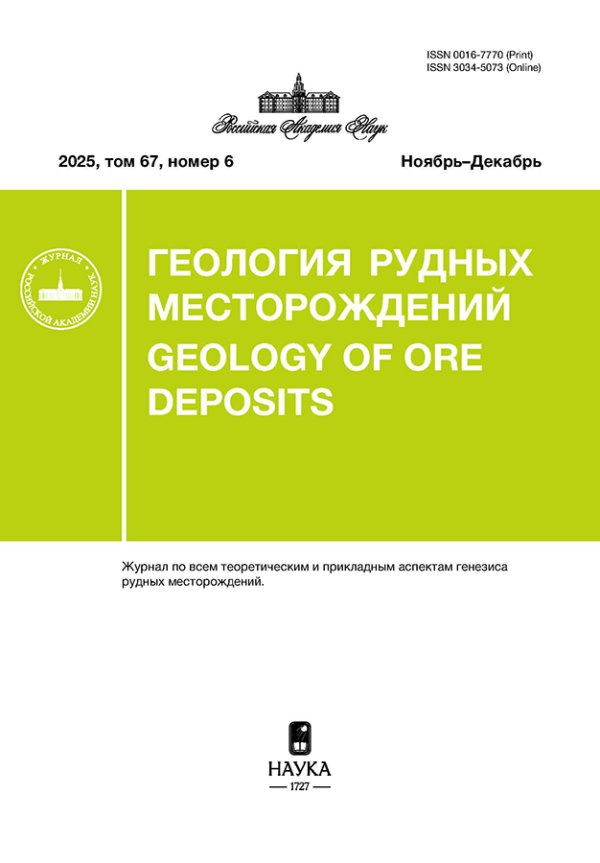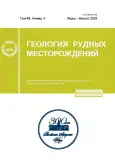Vol 65, No 4 (2023)
Articles
 289-301
289-301


Gorevsky polymetallic deposit (Siberia, Russia): mineral composition of ores and features of ore deposition
Abstract
The paper shows the genetic diversity of the structure and mineral composition of the ores of the Gorevsky Pb-Zn deposit, reveals the main signs of synchronous deposition of ore matter from near-bottom ore-bearing solutions associated with sedimentation processes in the sedimentary basin, considers textural and structural features and mineral associations of ores accompanying various metamorphism processes and postmagmatic processes. A model of the initially primary sedimentary-diagenetic origin of the ores of the Gorevsky Pb-Zn deposit under the conditions of catagenesis and the important role of the processes of redistribution and redeposition of the ore substance by interstitial solutions of the primary ore material is detailed. The study is based on the method of detailed study of the textural and structural features of ores in polished and polished samples. microstructural and mineral features and composition of ore and non-metallic minerals using modern methods of studying the substance. The bulk of the ores of the Gorevsky deposit demonstrate the textural and structural features of synsedimentary deposits, which are simultaneous with the host carbonaceous-micaceous-siliceous-carbonate rocks and retain these main structural features both at the macro and micro levels. The results obtained are compared and analyzed in comparison with other polymetallic deposits in Russia and in other regions of the world
 302-336
302-336


Sb-As LOJAN DEPOSIT (REPUBLIC OF NORTH MACEDONIA): ORE TYPES, CONDITIONS OF ORE TYPES LOCALIZATION AND GEOCHEMICAL FEATURES
Abstract
This article discusses the results of comprehensive studies of Sb-As ores of the Lojan deposit, located in the north-east of the Republic of North Macedonia (RSM), near the border with Serbia. 5 types of Sb-As ores have been identified: breccated realgar-auripigment ores, realgar breccias, breccated antimonite ores, massive, almost monomineral realgar ores, as well as realgar-antimonite nest-shaped ores. The ores are characterized not only by an unusual paragenesis of nickel, arsenic and antimony minerals, but also by a very close fusion of antimonite, realgar and collomorphic quartz. A wide range of elements in ores (As, Sb, Cr, Ti, Mn, Ni, Mo, Co, Ag, Tl, U, etc.) is apparently due to the combination of mineralization in ores of several different-time parageneses. As a result of thermometric studies of fluid inclusions in quartz, Thom vary from 180 OC to 220 OC (the average value is 201 OC). Studies of the isotopic composition of sulfur in antimonite and realgar have shown rather narrow ranges of δ34S values from -5.19 to -0.26 and from -4.80 to 1.92, respectively, which indicates an endogenous source of sulfur. The results obtained allow us to attribute the Lojan deposit to the epithermal class
 337-353
337-353


Association of Siderite with Iron Sulfides and Silicates in Rocks of Mikheevskoe Cu(Mo,Au) Porphyry Deposit (Southern Urals)
Abstract
The mineral association of siderite with Cu–Fe sulfides, cronstedtite, and goethite were first recognized when studying the Mikheevskoe Cu(Mo,Au)–porphyry deposit. This association is confined to fault zones, where it fills a network of mineralized fractures developed on porphyry- and argillizite-type ores. Minerals of this association were also identified in some argillizite samples of this deposit. The formation conditions of this mineral association and its relation to the evolution of the Late Paleozoic porphyry system or other endogenic–exogenic processes manifested during the subsequent geological history of the study area were studied. The integrated research included microprobe analysis and the measurement of O and C stable isotopes in minerals of the studied association in the “Geoanalitik” (Yekaterinburg) and “Geonauka” (Syktyvkar) Centers for Collective Use. The study of mineral compositions and their relationships indicates that the studied mineral association deposited at temperature of about 70° C from neutral or low-acid solutions HS–,13C with varying HS–, and aSiO2 (aq) contents. The measurements of .13C (from –5.5 to –18.2‰) and 18O (from 20.4 to 33.4‰) values in siderite made it possible to calculate the composition of a mineral-forming fluid. It was established that such a fluid has the following parameters: .18O H2O from –3 to +10‰ and 13C CO2 from 15 to –28‰. It could correspond to magmatogenic water fluids mixed with Corg-bearing surface water. Based on the obtained results, it is suggested that this mineral association is related to argillizites, the development of which occurred at the last stage of endogenic mineral formation at the Mikheevskoe deposit. Nevertheless, it is not excluded that it may be related with other low-T hydrothermal processes at the stage of Meso-Cenozoic tectonomagmatic activation of the Urals. There is no evidence of the relation of the studied mineral association with weathering crusts
 354-368
354-368












